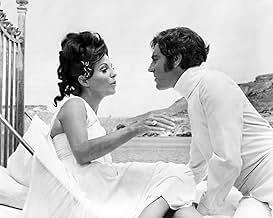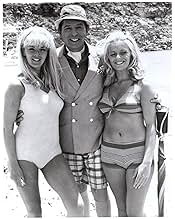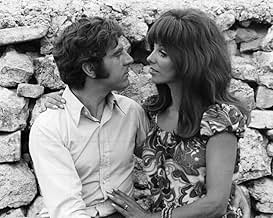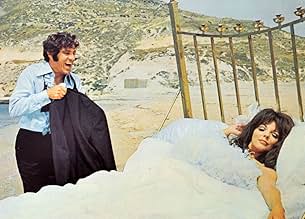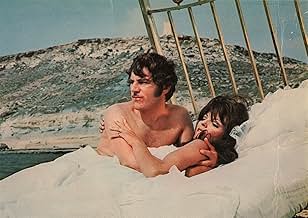Die Gelüste des Hieronymus
Originaltitel: Can Heironymus Merkin Ever Forget Mercy Humppe and Find True Happiness?
IMDb-BEWERTUNG
4,9/10
433
IHRE BEWERTUNG
Füge eine Handlung in deiner Sprache hinzuHeironymus Merkin screens an autobiographical movie of his life, growth, and moral decay.Heironymus Merkin screens an autobiographical movie of his life, growth, and moral decay.Heironymus Merkin screens an autobiographical movie of his life, growth, and moral decay.
- Regie
- Drehbuch
- Hauptbesetzung
- Auszeichnungen
- 1 wins total
Tara Newley Arkle
- Thumbelina
- (as Tara Newley)
Empfohlene Bewertungen
I've read some raves and some scathing reviews of this film. The reviewers seem wildly opposed.
What one should remember when viewing this work is the era when it was made. The world was a little different in the late '60s; the war in Vietnam was beginning to be opposed vehemently, nudity and profanity were being more tolerated in films, and a new era of permissiveness was dawning. Films that came out at this time were taking more "avante garde" chances, and there were as many misses as hits.
This film was a mixture of good and bad scenes, but never-the-less an interesting work. The humor in it is somewhat crude, and the music has neither enough polish, or conversely, edge to work completely.
I do remember being entertained by the film, and isn't that the bottom line? Trying to compare it to today's standards is not a valid comparison. No one would try to compare Chaplin's films with Eddie Murphy's. This work is one that will probably stay obscure, because it was more of an experiment than an expression.
Bottom line: A mixture of good and bad comedy, music and philosophy. See it for yourself and see if you can eke out a valid point of view.
What one should remember when viewing this work is the era when it was made. The world was a little different in the late '60s; the war in Vietnam was beginning to be opposed vehemently, nudity and profanity were being more tolerated in films, and a new era of permissiveness was dawning. Films that came out at this time were taking more "avante garde" chances, and there were as many misses as hits.
This film was a mixture of good and bad scenes, but never-the-less an interesting work. The humor in it is somewhat crude, and the music has neither enough polish, or conversely, edge to work completely.
I do remember being entertained by the film, and isn't that the bottom line? Trying to compare it to today's standards is not a valid comparison. No one would try to compare Chaplin's films with Eddie Murphy's. This work is one that will probably stay obscure, because it was more of an experiment than an expression.
Bottom line: A mixture of good and bad comedy, music and philosophy. See it for yourself and see if you can eke out a valid point of view.
Little seen ego-trip for the resistible talents of writer/producer/director/composer/star Anthony Newley (featuring his then-wife Joan Collins) which, due to its copious and gratuitous nudity (including its creator!), is surely the most notorious production ever to be filmed in Malta and, consequently, something of a holy grail for local film buffs! Given its unavailability, then, I wasn't overly disappointed in the poor (but certainly not unwatchable) quality of the print and the film itself, possessing a certain sense of style, wasn't as worthless as its reputation would have it!
In itself, a flashy and pretentious semi-autobiographical piece obviously inspired by Fellini's 8½ (1963), it's largely set on a beach where the protagonist is apparently mounting a film based on his own life (how self-indulgent can you get?). In fact, what plot there is resolves itself into a music-hall revue with plenty of rather quaint musical numbers (one of which is reprised ad nauseam throughout) by Newley and others. These, however, are often interrupted by the surprising presence of legendary American showmen George Jessel (as a wise-cracking, white-clad Angel Of Death figure, dubbed "The Presence") and Milton Berle as the Mephistophelean Goodtime Eddie Filth.
Newley's choice of character names is, if anything, admirably Fieldsan: indeed, here, Heironymus Merkin is torn between Collins' Polyester Poontang and Playboy playmate Connie Kreski's Mercy Humppe (hence the film's unwieldy title). Occasionally, too, Merkin is able to step out of character in order to observe his own actions enacted, in the interim, by a blank-faced dummy! Also incorporated is an irrelevant adult-oriented fairy-tale, entitled "The Princess And The Donkey", involving the intimate relationship between one Trampolena Whambang and a mule (which then turns into a dwarf!); amazingly, this infamous sequence was filmed in Malta's Presidential Palace!! The cast includes other familiar faces such as Stubby Kaye as Merkin's long-suffering scriptwriter and Victor Spinetti as a bewildered film critic who, perhaps justly, blames Fellini for Merkin's (and, by extension, Newley's) folie de grandeur.
There's a possible goof, too, in the appearance of a religious statue in the background during one of the beach sequences; this was supposedly removed for filming purposes and, consequently, has been the cause of much consternation locally to this day! I'm also confused by the film's actual running time: the X-rated version I watched, which one would assume to be uncut, ran for 107 mins. (with the trimmed R-rated version being 106 mins. long) but the BBFC gives its complete length as 117 mins.!
In itself, a flashy and pretentious semi-autobiographical piece obviously inspired by Fellini's 8½ (1963), it's largely set on a beach where the protagonist is apparently mounting a film based on his own life (how self-indulgent can you get?). In fact, what plot there is resolves itself into a music-hall revue with plenty of rather quaint musical numbers (one of which is reprised ad nauseam throughout) by Newley and others. These, however, are often interrupted by the surprising presence of legendary American showmen George Jessel (as a wise-cracking, white-clad Angel Of Death figure, dubbed "The Presence") and Milton Berle as the Mephistophelean Goodtime Eddie Filth.
Newley's choice of character names is, if anything, admirably Fieldsan: indeed, here, Heironymus Merkin is torn between Collins' Polyester Poontang and Playboy playmate Connie Kreski's Mercy Humppe (hence the film's unwieldy title). Occasionally, too, Merkin is able to step out of character in order to observe his own actions enacted, in the interim, by a blank-faced dummy! Also incorporated is an irrelevant adult-oriented fairy-tale, entitled "The Princess And The Donkey", involving the intimate relationship between one Trampolena Whambang and a mule (which then turns into a dwarf!); amazingly, this infamous sequence was filmed in Malta's Presidential Palace!! The cast includes other familiar faces such as Stubby Kaye as Merkin's long-suffering scriptwriter and Victor Spinetti as a bewildered film critic who, perhaps justly, blames Fellini for Merkin's (and, by extension, Newley's) folie de grandeur.
There's a possible goof, too, in the appearance of a religious statue in the background during one of the beach sequences; this was supposedly removed for filming purposes and, consequently, has been the cause of much consternation locally to this day! I'm also confused by the film's actual running time: the X-rated version I watched, which one would assume to be uncut, ran for 107 mins. (with the trimmed R-rated version being 106 mins. long) but the BBFC gives its complete length as 117 mins.!
This is an extraordinary film. But it's not for everyone, and it must be viewed in it's context.
There was a time when Anthony Newley was one of the biggest stars in the world. With two hit Broadway musicals and a slew of movies under his belt, and songs STILL being covered by today's artists ("Feeling Good" is currently enjoying a popular resurgence courtesy of Michael Buble'"), Universal Studios gave him carte blanche to make any movie he wanted. Newley had already established a proved track record of using his own life as source material. Making this kind of film was a logical next step for him.
In many respects, this film is a masterpiece. It is utterly unique; visually beautiful, it looks like a lucid dream. Newley was a master of symbolism, and the way he illustrates different levels of reality and different states of consciousness is nothing short of brilliant. Highly "Jungian", this film is meant be viewed and interpreted like a dream. Many reviewers have lambasted "Heironumus" for it's use of symbolism, but on the contrary, that is the beauty and magic of the film. Anyone familiar with the Western Hermetic Tradition will delight in the eloquence with which this movie speaks. It cannot be an accident that "Heironymus" was filmed in Malta, the home of the Knights Templar. It makes one question how deeply into the occult Newley must have been.
PLOT SUMMARY: Heironymus Merkin, a major star, is making a film about his own life, told as a fairy tale/epic myth. He is screening it for his mother and two toddler children. It is his intent that his children know the truth about who their father is, warts and all. The film-within-the-film is still in production, and Heironymus battles with the studio, writers, and critics for the integrity of his personal truth.
The film is:
about mid-life crisis
an exposition of internalized toxic shame
an examination of the repetition compulsion
A confession
a cry for help
a treatise on the unreality of life
a rare look at celebrity-hood from a celebrity's point of view
a self-portrait of a sex-addict
a dissertation on erotic mania
AND it's a musical-comedy.
The movie is many things, confusing, because Newley was himself confused. Then again, aren't we all to some degree? The greatest thing about "Heironymus" is all the questions it brings up. It inspires deep process, and that is what makes it Art, and a true gift to the world.
I am committed to helping this film finding it's audience.
There was a time when Anthony Newley was one of the biggest stars in the world. With two hit Broadway musicals and a slew of movies under his belt, and songs STILL being covered by today's artists ("Feeling Good" is currently enjoying a popular resurgence courtesy of Michael Buble'"), Universal Studios gave him carte blanche to make any movie he wanted. Newley had already established a proved track record of using his own life as source material. Making this kind of film was a logical next step for him.
In many respects, this film is a masterpiece. It is utterly unique; visually beautiful, it looks like a lucid dream. Newley was a master of symbolism, and the way he illustrates different levels of reality and different states of consciousness is nothing short of brilliant. Highly "Jungian", this film is meant be viewed and interpreted like a dream. Many reviewers have lambasted "Heironumus" for it's use of symbolism, but on the contrary, that is the beauty and magic of the film. Anyone familiar with the Western Hermetic Tradition will delight in the eloquence with which this movie speaks. It cannot be an accident that "Heironymus" was filmed in Malta, the home of the Knights Templar. It makes one question how deeply into the occult Newley must have been.
PLOT SUMMARY: Heironymus Merkin, a major star, is making a film about his own life, told as a fairy tale/epic myth. He is screening it for his mother and two toddler children. It is his intent that his children know the truth about who their father is, warts and all. The film-within-the-film is still in production, and Heironymus battles with the studio, writers, and critics for the integrity of his personal truth.
The film is:
about mid-life crisis
an exposition of internalized toxic shame
an examination of the repetition compulsion
A confession
a cry for help
a treatise on the unreality of life
a rare look at celebrity-hood from a celebrity's point of view
a self-portrait of a sex-addict
a dissertation on erotic mania
AND it's a musical-comedy.
The movie is many things, confusing, because Newley was himself confused. Then again, aren't we all to some degree? The greatest thing about "Heironymus" is all the questions it brings up. It inspires deep process, and that is what makes it Art, and a true gift to the world.
I am committed to helping this film finding it's audience.
After watching this film, I wondered if Anthony Newley thought that this would be his sole chance to direct a major film (which turned out to be true), so he decided togo on a binge with every idea he had at that point . It's in equal parts a mockumentary, a musical, and an homage to Tex Avery cartoons. Newley is the ringleader, Hieronymus Merkin, and he invites us to watch his carnal accomplishments and rise as a singer.
This movie features some fascinating production and costume design, and the beach sets are very unique. The jokes often hit sour notes, but the enthusiasm is contagious. I mean, really, what's better than seeing Joan Collins portray a character named " Polyester Poontang"? If you ever come across this movie, give it a chance.
:)
This movie features some fascinating production and costume design, and the beach sets are very unique. The jokes often hit sour notes, but the enthusiasm is contagious. I mean, really, what's better than seeing Joan Collins portray a character named " Polyester Poontang"? If you ever come across this movie, give it a chance.
:)
The title alone was enough to kill it dead in the water but if you got past that and made it into the few cinemas that showed it then the first ten minutes might have finished you off but this hugely self-indulgent picture is actually worth sticking around for. Okay, the gags are terrible and Newley, who directed it, co-wrote it, composed the music and plays the lead is no Orson Welles but there is a surfeit of imagination at work here and presuming it is mostly autobiographical, (his wife, Joan Collins, and children play his wife and children), few artists, and Newley surely is that, have ever been so self-critical in public; it's as if he wants us to hate him.
Fellini, of course, is the most obvious object of his affections, (he even gets a name-check), which probably riled the critics the most. How dare he think he could remake "8 1/2" and as a musical comedy, they probably screamed, and needless to say the film was not just a gigantic flop, both critically and commercially, but often figures in lists of the worst films ever made. It's certainly not always an easy watch; like a traffic accident it's very hard to look at what's happened yet impossible to look away. It's also impossible to ignore.
Fellini, of course, is the most obvious object of his affections, (he even gets a name-check), which probably riled the critics the most. How dare he think he could remake "8 1/2" and as a musical comedy, they probably screamed, and needless to say the film was not just a gigantic flop, both critically and commercially, but often figures in lists of the worst films ever made. It's certainly not always an easy watch; like a traffic accident it's very hard to look at what's happened yet impossible to look away. It's also impossible to ignore.
Wusstest du schon
- WissenswertesWhen this movie was originally released in 1969, some newspapers refused to advertise it, compelling cinephiles to call up their local theaters to learn the title. A few theaters even temporarily expanded their marquees to fit the entire title. Other theaters truncated the title to "Heironymous Merkin".
- PatzerThe color of Thumbelina's ice-cream cone changes between brown and white and pink.
- Zitate
Hieronymous Merkin: Then the Eskimo and the Indian and the cannibal all rush over to the knight and they say, "Your dragon was here and he's looking to terrify you a great deal." And the knight sits there, and he laughs, and he laughs, and he laughs. The moral of the story is, once you understand your own dragon, you don't have to be afraid anymore. See what I mean?
- Crazy CreditsThere are no opening credits. All credits come at the end. The actors take a bow on a custom-made, pastel-painted, portable stage on a beach as their names are credited in jagged, psychedelic print.
- Alternative VersionenThere is both an R-rated and an X-rated version. The R-rated version removes a few seconds of the sex scene with Mercy Humppe following the carousel sequence and tones down the suggestiveness of the "Princess and the Donkey" sequence. The X-rated version contains all the footage cut for the R version.
- VerbindungenFeatured in Ich bin Joan Collins! (2022)
- SoundtracksPiccadilly Lilly
(uncredited)
Performed by Anthony Newley and Bruce Forsyth
Music by Anthony Newley
Lyrics by Herbert Kretzmer
Top-Auswahl
Melde dich zum Bewerten an und greife auf die Watchlist für personalisierte Empfehlungen zu.
Details
- Erscheinungsdatum
- Herkunftsland
- Sprache
- Auch bekannt als
- .... Can Heironymus Merkin Ever Forget Mercy Humppe and Find True Happiness?
- Drehorte
- Malta(beach scenes)
- Produktionsfirmen
- Weitere beteiligte Unternehmen bei IMDbPro anzeigen
- Laufzeit
- 1 Std. 47 Min.(107 min)
Zu dieser Seite beitragen
Bearbeitung vorschlagen oder fehlenden Inhalt hinzufügen


